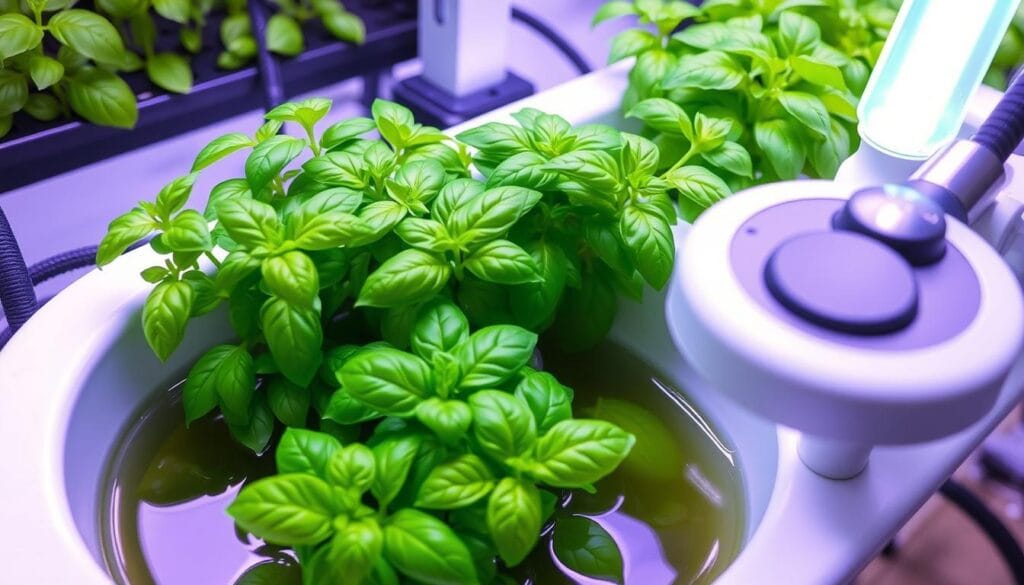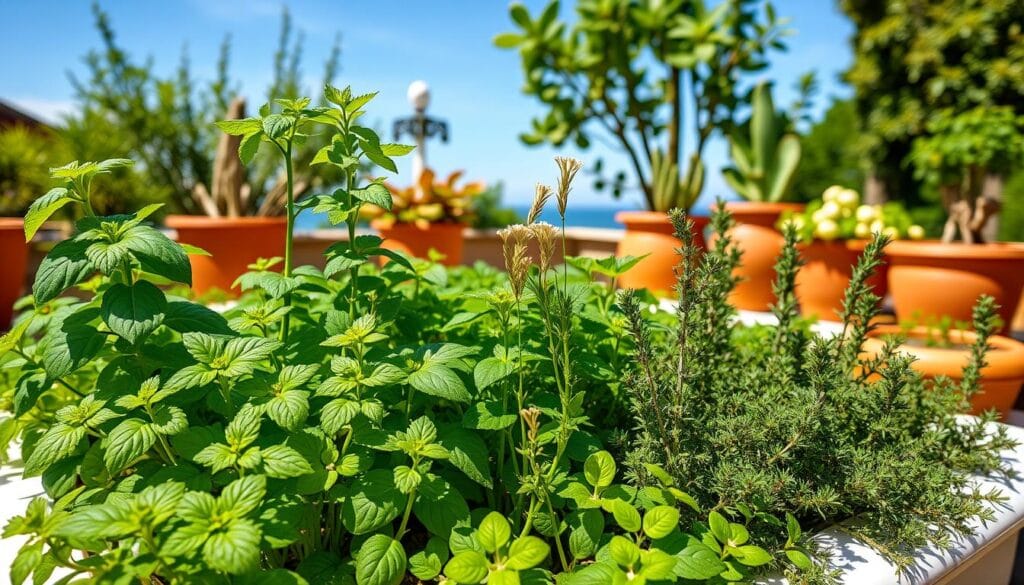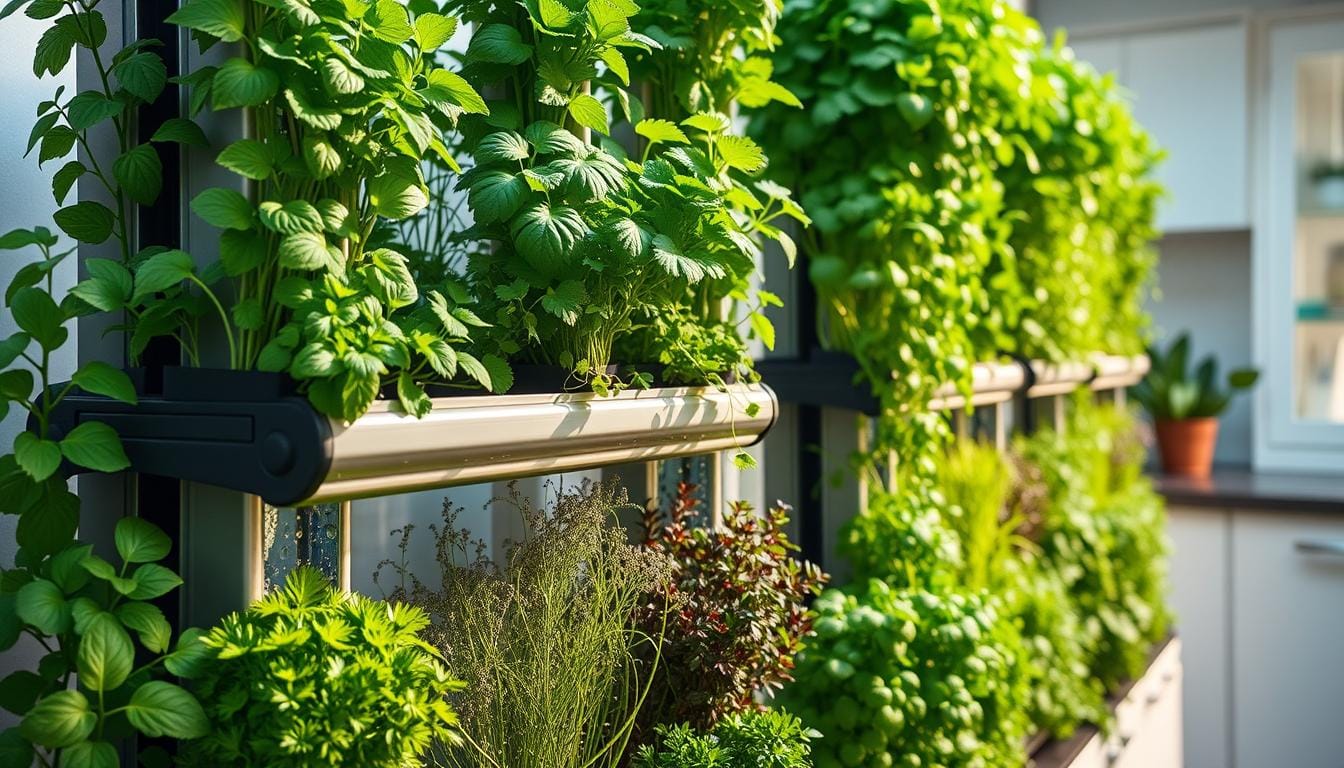Grow Hydroponically and enjoy a lush herb garden at home without the hassle of soil gardening. If you’ve ever dreamed of growing fresh herbs year-round but found traditional gardening challenging, you’re not alone. Hydroponic herb growing is a soil-free method that allows you to cultivate fresh herbs indoors, regardless of the weather or available space.
Hydroponic systems cost between $300 and $1,000, averaging $650. This is a good price for those wanting to try indoor herb gardening. It boosts herb production and makes them more aromatic, adding flavor to your cooking.
Key Takeaways
- Hydroponic systems offer a cost-effective and efficient way to grow herbs indoors year-round
- Herbs grown hydroponically tend to be more aromatic and flavorful due to increased oil production
- A wide variety of herbs, including basil, mint, and oregano, can be successfully cultivated using hydroponic methods
- Hydroponic herb gardens are space-efficient and can be tailored to fit any indoor environment
- Hydroponic herbs typically grow 30% faster than traditional soil-based herbs
Understanding Hydroponic Herb Gardening
Hydroponic gardening allows plants to grow without the need for soil. Instead, plants’ roots get a nutrient-rich solution. This method is becoming more popular for both home and commercial growers.
What is Hydroponic Growing?
In hydroponic systems, plants don’t need soil. Their roots soak in a water solution full of nutrients. This method helps plants grow faster, produce more, and grow better.
Benefits of Soil-Free Cultivation
- Consumes up to 90% less water compared to conventional gardening methods
- Plants grow up to 5 times faster than in soil
- Yields are higher and more consistent
- Less pests and diseases due to a closed system
- Can grow year-round indoors with the right light
Essential Equipment for Success
To start a hydroponic herb garden, you need:
- Grow lights or a bright indoor space
- A hydroponic system like DWC or NFT
- Nutrient solutions for herbs, with the right balance
- pH testing and adjustment tools
Learning about hydroponic gardening and getting the right tools helps. You can then grow a thriving indoor herb garden. It will give you fresh, flavorful herbs all year.
Why Choose Hydroponic Herbs for Indoor Growing
Hydroponic growing of herbs is a great choice for indoor gardening. It lets you grow plants all year, no matter the weather outside. This is perfect for city folks and those with little space.
Herbs grown with hydroponics taste better and smell stronger than those grown in soil. This is because you can control everything they need. Indoor gardens can even produce over 25 pounds of food every 28 days.
These systems need just a small space and are easy to care for. They use much less water than farming outdoors. This makes them a smart choice for growing herbs.
New hydroponic tech has made it easy for anyone to grow herbs indoors. Kits like Aerogarden, Click & Grow, and Gardyn make it simple. Even beginners can grow herbs and greens all year.
Hydroponic growing offers many benefits. You get more food, better taste, and save water. It’s also low maintenance. With this method, you can always have fresh herbs, no matter the season or your outdoor space.
| Hydroponic System | Key Features | Capacity |
|---|---|---|
| Aerogarden | Automated watering and lighting, compact design | 12-24 plants |
| Click & Grow Smart Garden | Self-watering, smart sensor technology, pre-seeded plant pods | 3-9 plants |
| Gardyn | Vertical growing, AI-powered, biodegradable plant pods | Up to 30 plants |
“With the right setup, hydroponics can produce over 25 pounds of fresh food every 28 days.”
Herbs to Grow Hydroponically: Complete Guide
Hydroponic gardening lets you grow many herbs at home. You can grow everything from basil to mint. This guide will help you learn about herb grow lights and herb crop management.
Best Growing Systems for Herbs
Choosing the right hydroponic system is key. The Deep Water Culture (DWC) and Nutrient Film Technique (NFT) systems work great for herbs. They give herbs the water, nutrients, and oxygen they need to grow well.
Optimal Growing Conditions
Herbs need the right conditions to grow well. They do best with 12 to 16 hours of light and temperatures between 65°F and 75°F. Keeping the pH between 5.5 and 6.5 is also important for nutrient absorption.
Nutrient Solutions and pH Levels
Getting the nutrient solution and pH levels right is crucial. Each herb has different needs, so it’s important to tailor the nutrient mix. Regularly check and adjust the pH to keep it in the ideal range. With the right care, your herbs will grow well and taste great.
Learning about the best systems, conditions, and nutrients for hydroponic herbs will help you grow a great indoor garden. Your garden will make your cooking better and bring fresh flavors right to your kitchen.
Basil: The Perfect Starter Herb
Basil is a great herb for beginners in hydroponic gardening. It’s easy to grow and gives lots of tasty leaves. Growing basil hydroponically has many benefits for indoor gardeners.
Basil grows fast in a hydroponic setup. Using a deep water culture (DWC) system with an air pump helps it grow even bigger. Seeds are cheap and sprout quickly, and cuttings give instant results.
Basil likes a pH of 6.0 – 6.5 in the nutrient solution. It needs 6-8 hours of bright light a day. Good grow lights are key for indoor hydroponic basil cultivation. Pruning keeps the plants bushy and boosts leaf production.
Basil comes in many varieties like Thai, lemon, and purple basil. Each offers different tastes and colors for cooking. By learning what basil needs, you can grow a great hydroponic basil garden at home.
“Hydroponic basil is a revolution for home chefs, offering a steady, aromatic, and year-round source of this vital herb, ensuring freshness at all times”.

Mint: Growing and Maintaining
Growing mint hydroponically can be very rewarding. This herb does well without soil, giving you plenty of fresh flavor. To keep your mint happy, you need to know what it likes.
Different Mint Varieties
There are many mint types to try in your hydroponic garden. You can choose from peppermint to spearmint, each with its own taste. Trying different kinds can make your garden more interesting.
Harvesting and Storage Tips
It’s important to pick mint often to keep it healthy. Cut off leaves as you need them, but leave some stem. This helps the plant grow more. You can dry or freeze mint to keep its flavor for longer.
Common Growing Challenges
Mint is usually easy to grow, but hydroponic growers might face some issues. You might need to control its spread, make sure it gets the right nutrients, and prevent root rot. By being careful and quick to fix problems, you can have a great mint crop.
Hydroponic mint growing has many benefits. It’s flavorful and does well indoors. By knowing what mint needs and following best practices, you can enjoy the benefits of hydroponic mint growing and have your own mint garden.
Oregano and Thyme: Mediterranean Favorites
Oregano and thyme are beloved herbs in Mediterranean cooking. They grow well in hydroponic systems. These herbs add flavor and Mediterranean flair to indoor gardens.
Oregano: The Versatile Herb
Oregano, known as Origanum vulgare, is a hardy herb. It needs 6-8 hours of light and a pH of 6.0-8.0 to grow well. It’s ready to harvest in 20-25 days, making it a quick addition to your garden.
Thyme: Aromatic Delights
Thyme grows slower, needing 8-10 hours of light and a pH of 5.5-7.0. It takes 60-80 days to grow. Its unique flavor is a key ingredient in Mediterranean dishes.
Both oregano and thyme prefer warmer temperatures, perfect for indoor hydroponic growing. Their strong aromas and tastes are essential in Mediterranean cooking. Now, you can grow these hydroponic Mediterranean herbs at home.
“Oregano and thyme are the heart and soul of Mediterranean cooking. Their flavors are unrivaled, and with a hydroponic setup, you can enjoy them year-round.”
| Herb | Light Requirement | pH Range | Growth Time |
|---|---|---|---|
| Oregano | 6-8 hours | 6.0-8.0 | 20-25 days |
| Thyme | 8-10 hours | 5.5-7.0 | 60-80 days |

Growing Parsley and Sage in Your System
Parsley and sage are key herbs for hydroponic gardens. They add flavor to food and offer health benefits. Here’s how to grow them well, including light needs, care, and fixing common problems.
Light Requirements
Parsley needs 12-16 hours of light daily, best at pH 5.5-6.8. Sage prefers 6-8 hours of light, with pH 5.5-6.5. Right lighting helps your herbs grow strong.
Maintenance Schedule
- Parsley takes 70-90 days to grow, while sage needs 75-85 days.
- Prune both herbs often to keep them bushy and flavorful.
- Check your nutrient and pH levels regularly for healthy growth.
Troubleshooting Guide
Common issues with parsley and sage include nutrient shortages and root rot. Keep your system clean and well-oxygenated. Ensure the right nutrient balance and pH. With careful monitoring, you can fix these problems and enjoy a rich harvest.
| Herb | Light Requirement | pH Range | Maturity Time |
|---|---|---|---|
| Parsley | 12-16 hours | 5.5-6.8 | 70-90 days |
| Sage | 6-8 hours | 5.5-6.5 | 75-85 days |
Knowing what parsley and sage need helps you grow a lush indoor garden. This garden will give you fresh herbs for your cooking.
Advanced Tips for Hydroponic Herb Success
Whether you’re new to hydroponic herb growing or have been doing it for a while, there’s always room for improvement. You can refine your techniques and get even better results. Tips like succession planting and adjusting nutrient levels can elevate your hydroponic herb garden.
Succession planting is a smart strategy. It means planting herbs in batches to keep a steady supply. For instance, plant chives in batches to have a continuous crop all season.
It’s important to check and adjust the nutrient levels in your hydroponic system often. Each herb has its own needs. Adjust the nutrients as your plants grow. The best pH for hydroponic herbs is between 5.5 and 6.5 for best nutrient absorption.
Try different lighting spectrums to improve your herbs’ flavor and aroma. While LED lights are great, tweaking the red and blue wavelengths can make a difference.
Lastly, change the water in your hydroponic system often. This prevents algae and keeps your system clean. A clean system means healthier herbs and more harvests.
| Hydroponic Herb Technique | Key Benefits |
|---|---|
| Succession Planting | Ensures a continuous supply of fresh herbs |
| Nutrient Level Monitoring | Optimizes plant growth and development |
| Lighting Spectrum Experimentation | Enhances flavor and aroma of herbs |
| Regular Water Changes | Prevents algae buildup and maintains system health |
Using these advanced techniques will help you succeed in hydroponic herb gardening. Always observe, experiment, and adjust to find what works best for you and your herbs.
Conclusion
Hydroponic herb gardening is a green and efficient way to grow herbs all year. It lets you control growing conditions closely, leading to better herbs. Whether you’re new or experienced, the right setup and knowledge can help you grow tasty herbs.
Hydroponic gardening saves space and water. It also means less use of harmful pesticides. This method is great for those who love herbs and care about the environment.
Starting your hydroponic herb garden? Think about the herbs you want and your indoor space. With the right tools and care, you’ll have a lot of fresh, healthy herbs. These will make your cooking better and bring nature’s flavors into your kitchen.

